Securing U.S. Democracy: Athenian Project Update

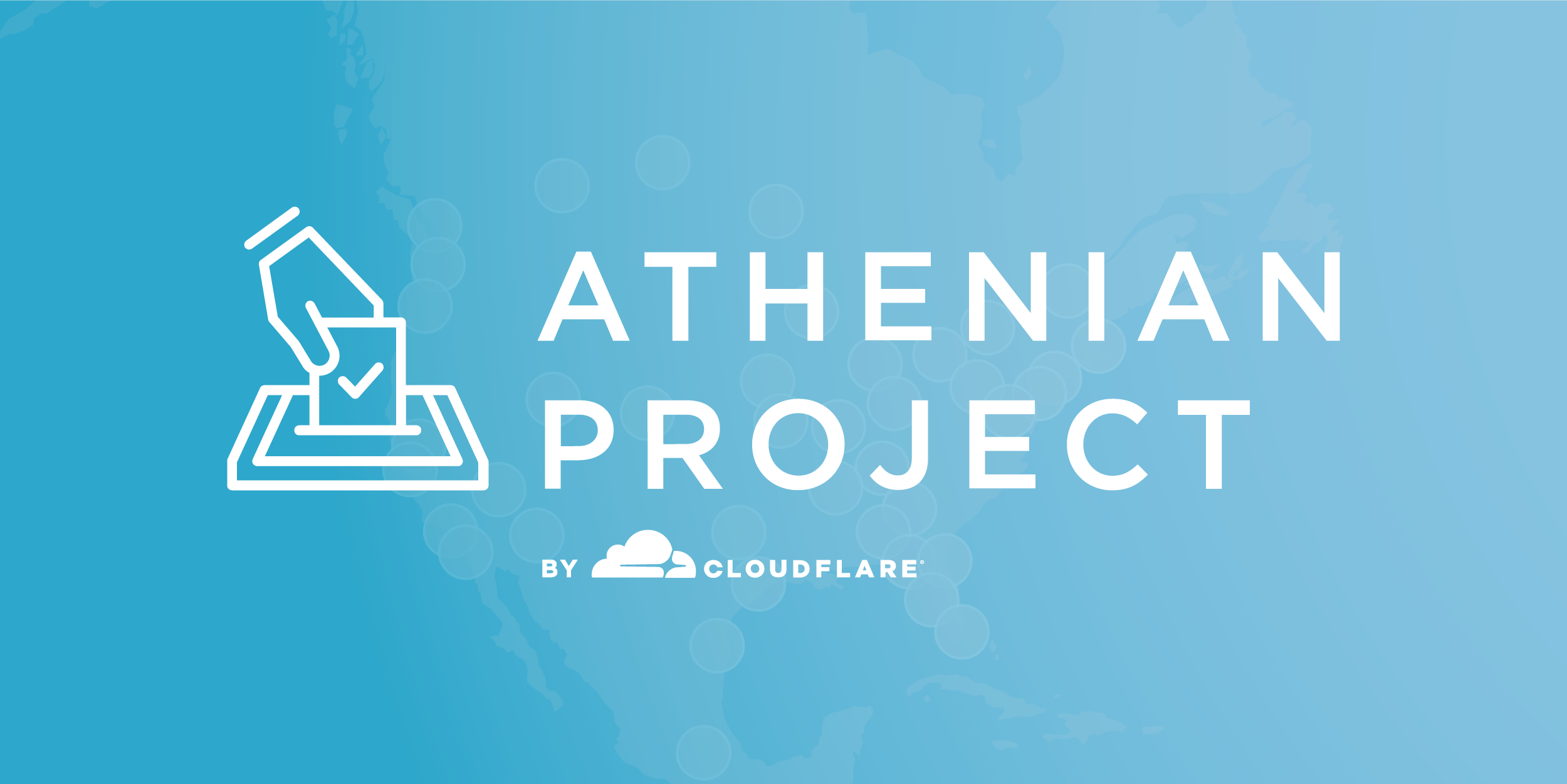
Last December, Cloudflare announced the Athenian Project to help protect U.S. state and local election websites from cyber attack.
Since then, the need to protect our electoral systems has become increasingly urgent. As described by Director of National Intelligence Dan Coats, the “digital infrastructure that serves this country is literally under attack.” Just last week, we learned new details about how state election systems were targeted for cyberattack during the 2016 election. The U.S. government’s indictment of twelve Russian military intelligence officers describes the scanning of state election-related websites for vulnerabilities and theft of personal information related to approximately 500,000 voters.
This direct attack on the U.S. election systems using common Internet vulnerabilities reinforces the need to ensure democratic institutions are protected from attack in the future. The Athenian Project is Cloudflare’s attempt to do our part to secure our democracy.
Engaging with Elections Officials
Since announcing the Athenian Project, we’ve talked to state, county, and municipal officials around the country about protecting their election and voter registration websites. Today, we’re proud to report that we have Athenian Project participants in 19 states, and are in talks with many more. We have also strategized with civil Continue reading
IPv6 in China

Photo by chuttersnap / Unsplash
At the end of 2017, Xinhua reported that there will be 200 Million IPv6 users inside Mainland China by the end of this year. Halfway into the year, we’re seeing a rapid growth in IPv6 users and traffic originating from Mainland China.
Why does this matter?
IPv6 is often referred to the next generation of IP addressing. The reality is, IPv6 is what is needed for addressing today. Taking the largest mobile network in China today, China Mobile has over 900 Million mobile subscribers and over 670 Million 4G/LTE subscribers. To be able to provide service to their users, they need to provide an IP address to each subscriber’s device. This means close to a billion IP addresses would be required, which is far more than what is available in IPv4, especially as the available IP address pools have been exhausted.
What is the solution?
To solve the addressability of clients, many networks, especially mobile networks, will use Carrier Grade NAT (CGN). This allows thousands, possibly up to hundreds of thousands, of devices to be shared behind a single internet IP address. The CGN equipment can be very expensive to scale and further, given the Continue reading
Proxying traffic to Report URI with Cloudflare Workers

The following is a guest post by Scott Helme, a Security Researcher, international speaker, and blogger. He's also the founder of the popular securityheaders.com and report-uri.com, free tools to help people deploy better security.
With the continued growth of Report URI we're seeing a larger and larger variety of sites use the service. With that diversity comes additional requirements that need to be met, some of them simple and some of them less so. Here's a quick look at those challenges and how they can be solved easily with a Cloudflare Worker. Continue reading
DNS-Over-TLS Built-In & Enforced – 1.1.1.1 and the GL.iNet GL-AR750S
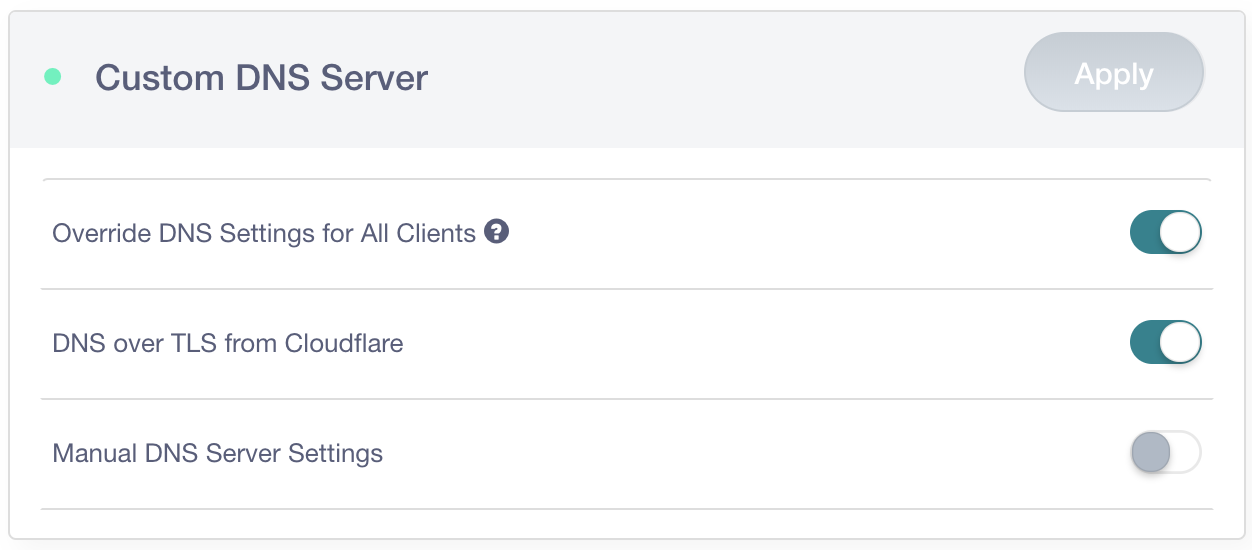
 GL.iNet GL-AR750S in black, same form-factor as the prior white GL.iNet GL-AR750. Credit card for comparison.
GL.iNet GL-AR750S in black, same form-factor as the prior white GL.iNet GL-AR750. Credit card for comparison.
Back in April, I wrote about how it was possible to modify a router to encrypt DNS queries over TLS using Cloudflare's 1.1.1.1 DNS Resolver. For this, I used the GL.iNet GL-AR750 because it was pre-installed with OpenWRT (LEDE). The folks at GL.iNet read that blog post and decided to bake DNS-Over-TLS support into their new router using the 1.1.1.1 resolver, they sent me one to take a look at before it's available for pre-release. Their new router can also be configured to force DNS traffic to be encrypted before leaving your local network, which is particularly useful for any IoT or mobile device with hard-coded DNS settings that would ordinarily ignore your routers DNS settings and send DNS queries in plain-text.

In my previous blog post I discussed how DNS was often the weakest link in the chain when it came to browsing privacy; whilst HTTP traffic is increasingly encrypted, this is seldom the case for DNS traffic. This makes it relatively trivial for an intermediary to work out what site you're sending Continue reading
Introducing Proudflare, Cloudflare’s LGBTQIA+ Group


With Pride month now in our collective rearview mirror for 2018, I wanted to share what some of us have been up to at Cloudflare. We're so proud that, in the last 8 months, we've formed a LGBTQIA+ Employee Resource Group (ERG) called Proudflare. We've launched chapters and monthly activities in each of our primary locations: San Francisco, London, Singapore, and Austin. This month, we came out in force! We transformed our company's social profiles, wrapped our HQ building in rainbow window decals, highlighted several non-profits we support, and threw a heck of an inaugural Pride Celebration.
We’re a very young group — just 8 months old — but we have big plans. Check out some of our activities and future plans, follow us on social media, and consider starting an ERG at your company too.
The History of Proudflare
On my first day at Cloudflare in October, 2017, I logged into Hipchat and searched LGBTQ. Fortunately for me, there was a "LGBT at Cloudflare" chat room already created, and I started establishing connections right away. I found that there had been a couple of informal group outings, but there was no regular activity, sharing of resources, nor an official Continue reading
Comparing Serverless Performance for CPU Bound Tasks
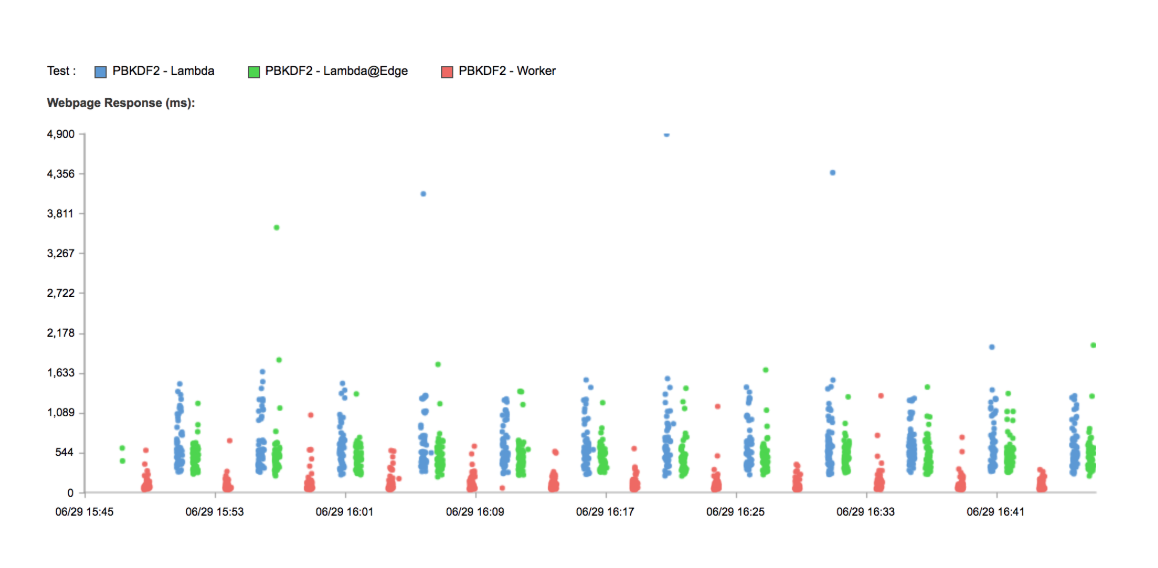
This post is a part of an ongoing series comparing the performance of Cloudflare Workers with other Serverless providers. In our past tests we intentionally chose a workload which imposes virtually no CPU load (returning the current time). For these tests, let's look at something which pushes hardware to the limit: cryptography.
tl;dr Cloudflare Workers are seven times faster than a default Lambda function for workloads which push the CPU. Workers are six times faster than Lambda@Edge, tested globally.
Slow Crypto
The PBKDF2 algorithm is designed to be slow to compute. It's used to hash passwords; its slowness makes it harder for a password cracker to do their job. Its extreme CPU usage also makes it a good benchmark for the CPU performance of a service like Lambda or Cloudflare Workers.
We've written a test based on the Node Crypto (Lambda) and the WebCrypto (Workers) APIs. Our Lambda is deployed to with the default 128MB of memory behind an API Gateway in us-east-1, our Worker is, as always, deployed around the world. I also have our function running in a Lambda@Edge deployment to compare that performance as well. Again, we're using Catchpoint to test from hundreds of locations around Continue reading
How To Minikube + Cloudflare

The following is a guest blog post by Nathan Franzen, Software Engineer at StackPointCloud. StackPointCloud is the creator of Stackpoint.io, the leading multi-cloud management platform for cloud native workloads. They are the developers of the Cloudflare Ingress Controller for Kubernetes.
Deploying Applications on Minikube with Argo Tunnels
This article assumes basic knowledge of Kubernetes. If you're not familiar with Kubernetes, visit https://kubernetes.io/docs/tutorials/kubernetes-basics/ to learn the basics.
Minikube is a tool which allows you to run a Kubernetes cluster locally. It’s not only a great way to experiment with Kubernetes, but also a great way to try out deploying services using a reverse tunnel.
At Cloudflare, we've created a product called Argo Tunnel which allows you to host services through a tunnel using Cloudflare as your edge. Tunnels provide a way to expose your services to the internet by creating a connection to Cloudflare's edge and routing your traffic over it. Since your service is creating its own outbound connection to the edge, you don’t have to open ports, configure a firewall, or even have a public IP address for your service. All traffic flows through Cloudflare, blocking attacks and intrusion attempts before they ever make it to Continue reading
How to drop 10 million packets per second

Internally our DDoS mitigation team is sometimes called "the packet droppers". When other teams build exciting products to do smart things with the traffic that passes through our network, we take joy in discovering novel ways of discarding it.

CC BY-SA 2.0 image by Brian Evans
Being able to quickly discard packets is very important to withstand DDoS attacks.
Dropping packets hitting our servers, as simple as it sounds, can be done on multiple layers. Each technique has its advantages and limitations. In this blog post we'll review all the techniques we tried thus far.
Test bench
To illustrate the relative performance of the methods we'll show some numbers. The benchmarks are synthetic, so take the numbers with a grain of salt. We'll use one of our Intel servers, with a 10Gbps network card. The hardware details aren't too important, since the tests are prepared to show the operating system, not hardware, limitations.
Our testing setup is prepared as follows:
-
We transmit a large number of tiny UDP packets, reaching 14Mpps (millions packets per second).
-
This traffic is directed towards a single CPU on a target server.
-
We measure the number of packets handled by the kernel on that Continue reading
초당 천만개의 패킷을 버리는 방법

This is a Korean translation of a prior post by Marek Majkowski.
사내에서 DDoS 대응팀은 종종 "패킷 버리는 사람들"이라 불립니다. 다른 팀이 우리 네트워크를 통해 지나가는 트래픽으로 스마트한 일을 하며 신나할 때 우리는 그걸 버리는 여러가지 방법을 찾아가며 즐거워 합니다.

CC BY-SA 2.0 image by Brian Evans
DDoS 공격을 견뎌내기 위해서는 빠르게 패킷을 버릴 수 있는 능력이 매우 중요합니다.
쉽게 들리겠지만 서버에 도달한 패킷을 버리는 것은 여러 단계에서 가능합니다. 각 기법은 장점과 한계점이 있습니다. 이 블로그 글에서는 지금까지 시도해 본 기법들을 모두 정리해 보도록 하겠습니다.
테스트 벤치마크
각 기법의 상대적인 성능을 시각화하기 위해서 먼저 숫자를 볼 것입니다. 벤치마크는 합성 테스트이므로 실제 숫자와는 일부 차이가 있을 수 있습니다. 테스트를 위해서는 10Gbps 네트워크 카드가 달린 인텔 서버를 사용할 것입니다. 하드웨어가 아니라 운영체제의 한계를 보여주기 위한 테스트이므로 하드웨어의 상세 사항은 적지 않겠습니다.
테스트 설정은 다음과 같습니다:
- 작은 크기의 UDP 패킷을 14Mpps (Mpps = 초당 백만 패킷) 에 도달하도록 대량으로 전송
- 이 트래픽은 테스트 서버의 단일 CPU에 전달되도록 함
- 단일 CPU에서 커널에 의해 처리되는 패킷의 개수를 측정
테스트는 사용자 공간 어플리케이션의 속도나 패킷 처리 속도를 최대화하려는 것이 아니라 커널의 병목 지점을 알고자 하는 것입니다.
합성 트래픽은 conntrack에 최대한의 부하를 주도록 준비되었습니다 - 임의의 소스 IP와 포트 필드를 사용합니다. tcpdump는 다음과 같이 Continue reading
Simple DDNS solution supporting IPv6 and your own domains using Cloudflare and some Python
I think it is safe to say that most of IT professionals have some kind of lab environment and many of us have some kind of lab at home. Sometimes it is necessary to use resources from that lab outside of the house, which means they need to be exposed to the Internet and you […]Debugging Serverless Apps
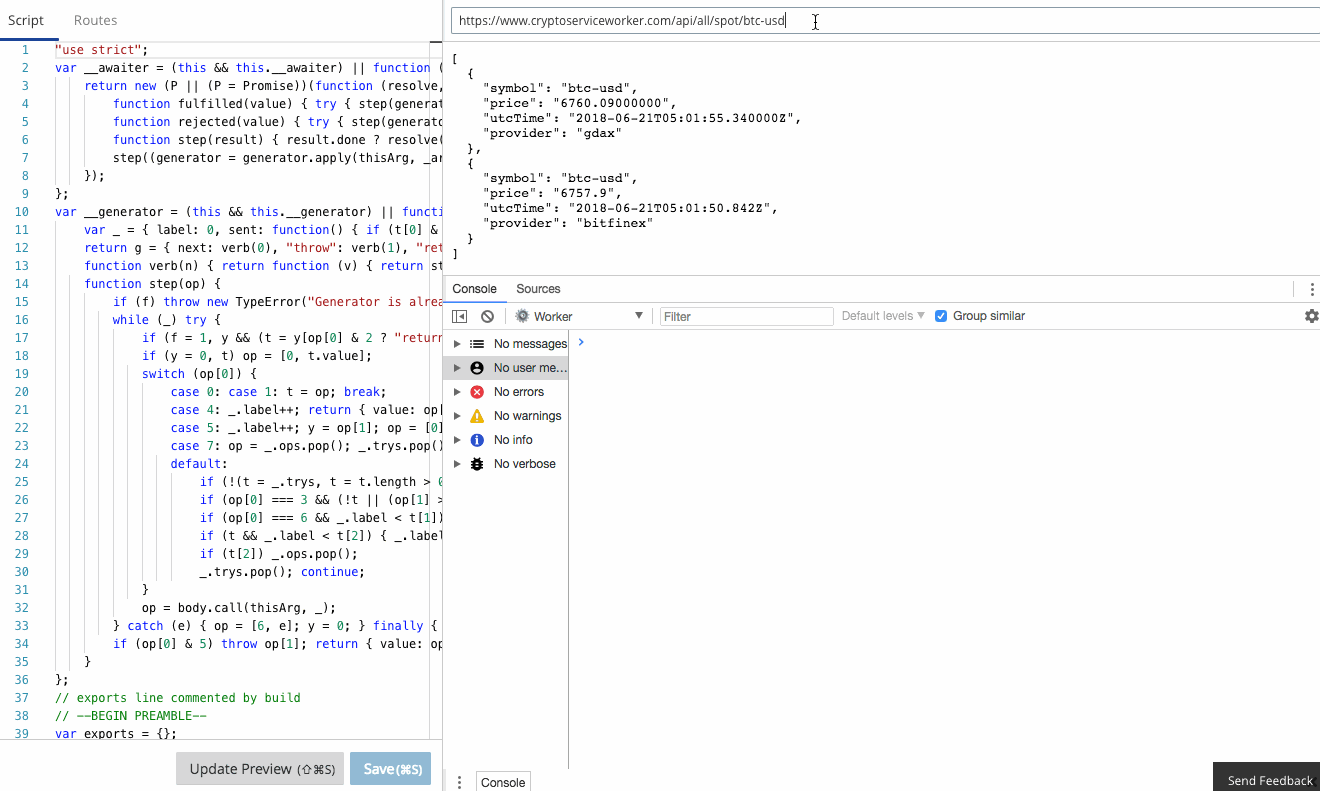
The Workers team have already done an amazing job of creating a functional, familiar edit and debug tooling experience in the Workers IDE. It's Chrome Developer Tools fully integrated to Workers.
console.log in your Worker goes straight to the console, just as if you were debugging locally! Furthermore, errors and even log lines come complete with call-site info, so you click and navigate straight to the relevant line.
In this blog post I’m going to show a small and powerful technique I use to make debugging serverless apps simple and quick.
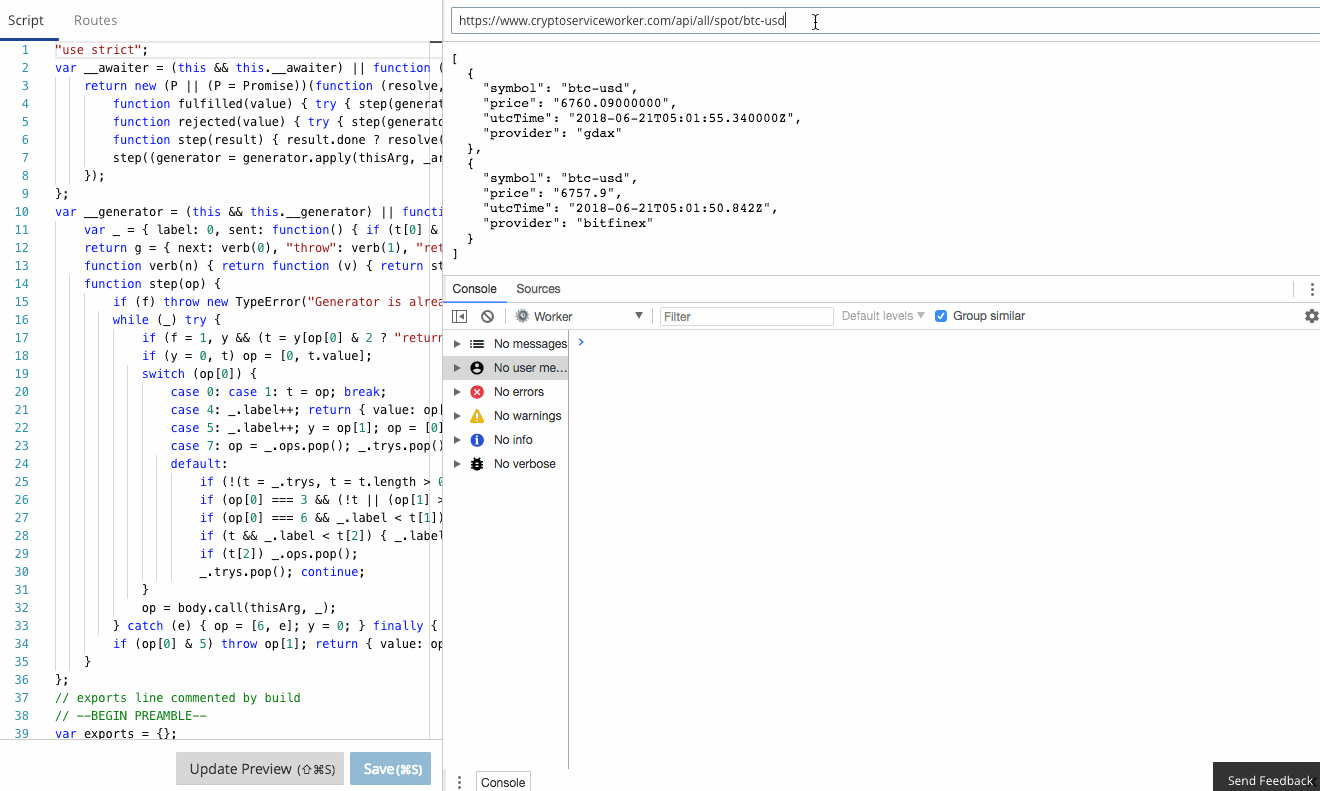
There is a comprehensive guide to common debugging approaches and I'm going to focus on returning debug information in a header. This is a great tip and one that I use to capture debug information when I'm using curl or Postman, or integration tests. It was a little finicky to get right the first time, so let me save you some trouble.
If you've followed part 1 or part 2 of my Workers series, you'll know I'm using Typescript, but the approach would equally apply to Javascript. In the rest of this example, I’ll be using the routing framework I created in part 2.
Requesting Debug Info
Too Old To Rocket Load, Too Young To Die

Rocket Loader is in the news again. One of Cloudflare's earliest web performance products has been re-engineered for contemporary browsers and Web standards.
No longer a beta product, Rocket Loader controls the load and execution of your page JavaScript, ensuring useful and meaningful page content is unblocked and displayed sooner.
For a high-level discussion of Rocket Loader aims, please refer to our sister post, We have lift off - Rocket Loader GA is mobile!
Below, we offer a lower-level outline of how Rocket Loader actually achieves its goals.
Prehistory
Early humans looked upon Netscape 2.0, with its new ability to script HTML using LiveScript, and <BLINK>ed to ensure themselves they weren’t dreaming. They decided to use this technology, soon to be re-christened JavaScript (a story told often and elsewhere), for everything they didn’t know they needed: form input validation, image substitution, frameset manipulation, popup windows, and more. The sole requirement was a few interpreted commands enclosed in a <script> tag. The possibilities were endless.

Soon, the introduction of the src attribute allowed them to import a file full of JS into their pages. Little need to fiddle with the markup, when all the requisite JS for the page Continue reading
Serverless Performance: Cloudflare Workers, Lambda and Lambda@Edge
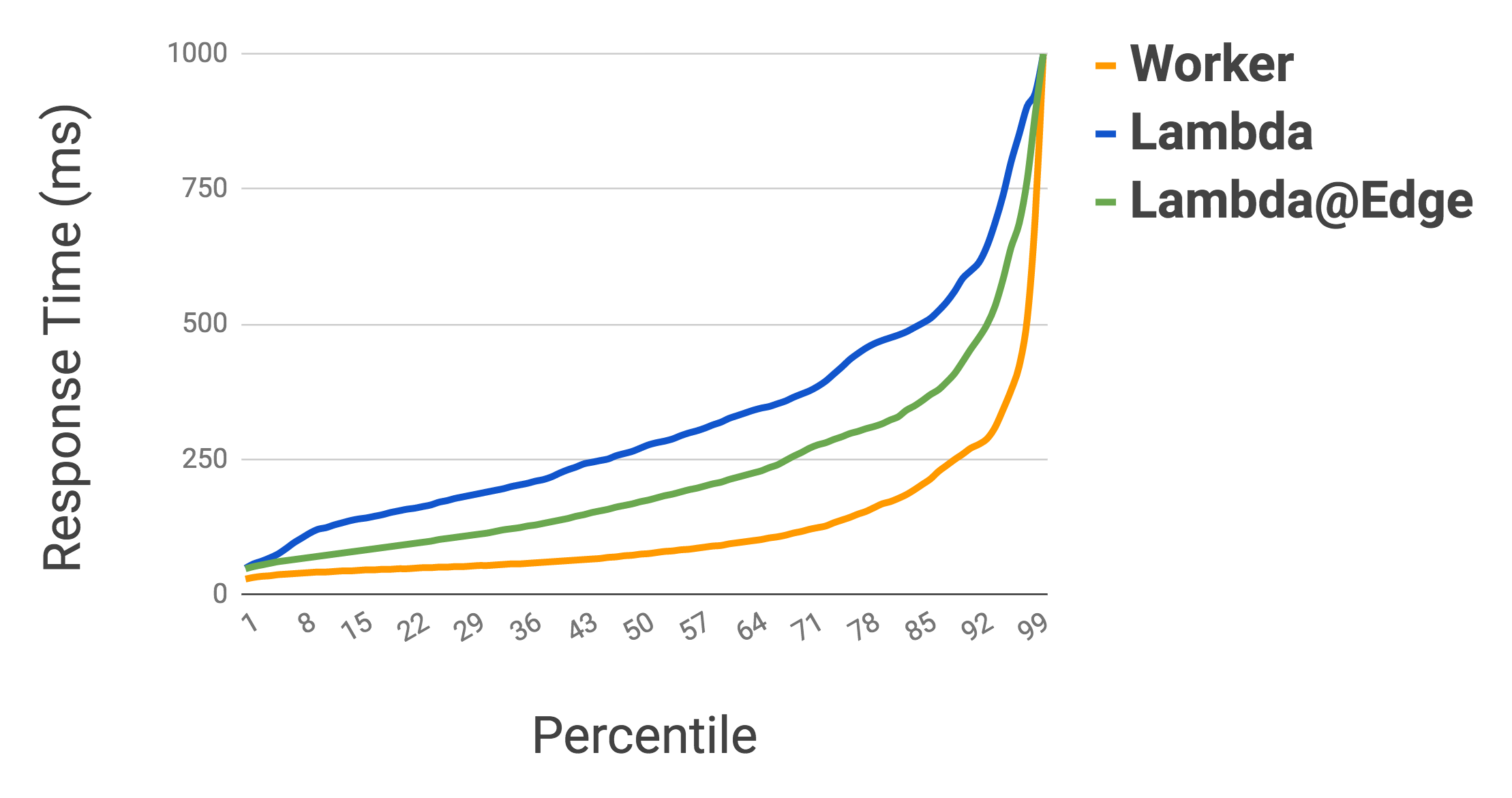
A few months ago we released a new way for people to run serverless Javascript called Cloudflare Workers. We believe Workers is the fastest way to execute serverless functions.
If it is truly the fastest, and it is comparable in price, it should be how every team deploys all of their serverless infrastructure. So I set out to see just how fast Worker execution is and prove it.
tl;dr Workers is much faster than Lambda and Lambda@Edge:
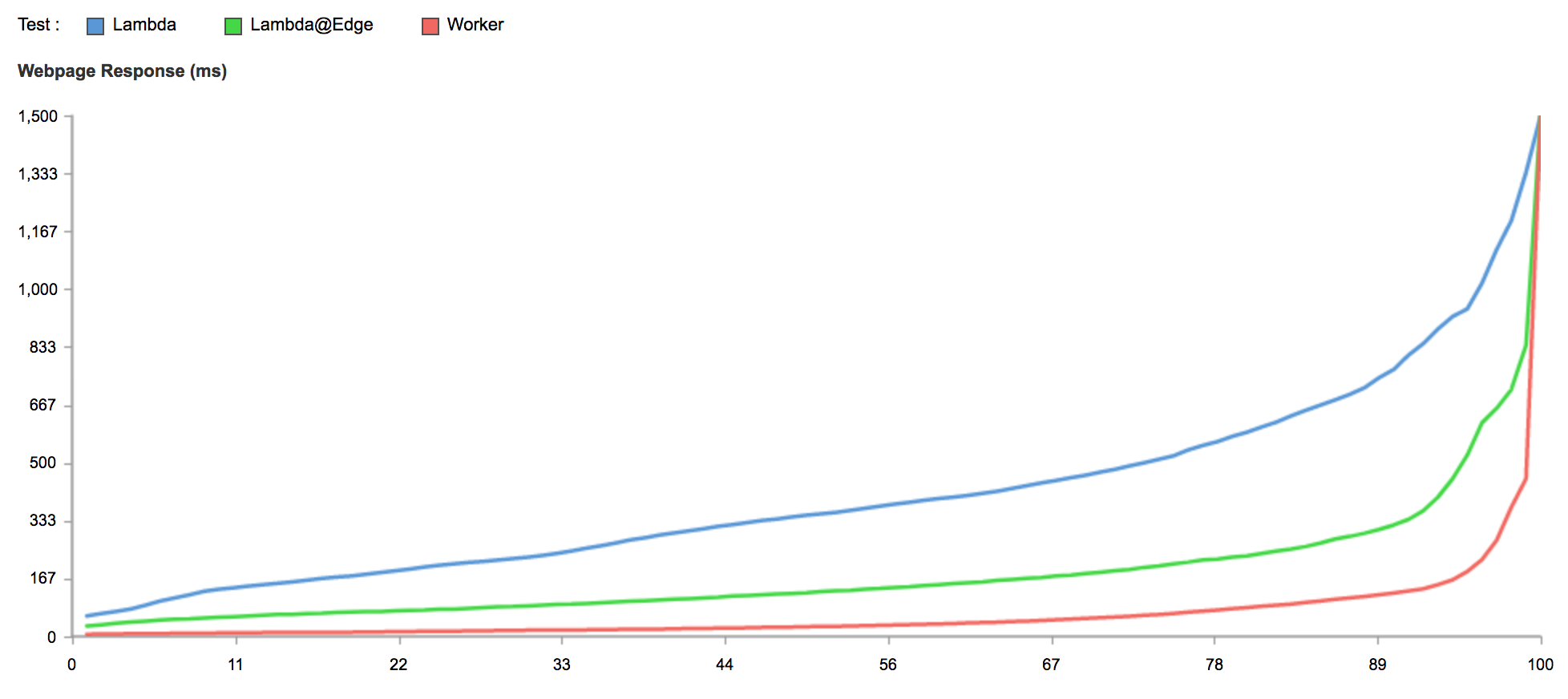
This is a chart showing what percentage of requests to each service were faster than a given number of ms. It is based on thousands of tests from all around the world, evenly sampled over the past 12 hours. At the 95th percentile, Workers is 441% faster than a Lambda function, and 192% faster than Lambda@Edge.
The functions being tested simply return the current time. All three scripts are available on Github. The testing is being done by a service called Catchpoint which has hundreds of testing locations around the world.
The Gold Coast
This is every test ran in the last hour, with results over 1500ms filtered out:
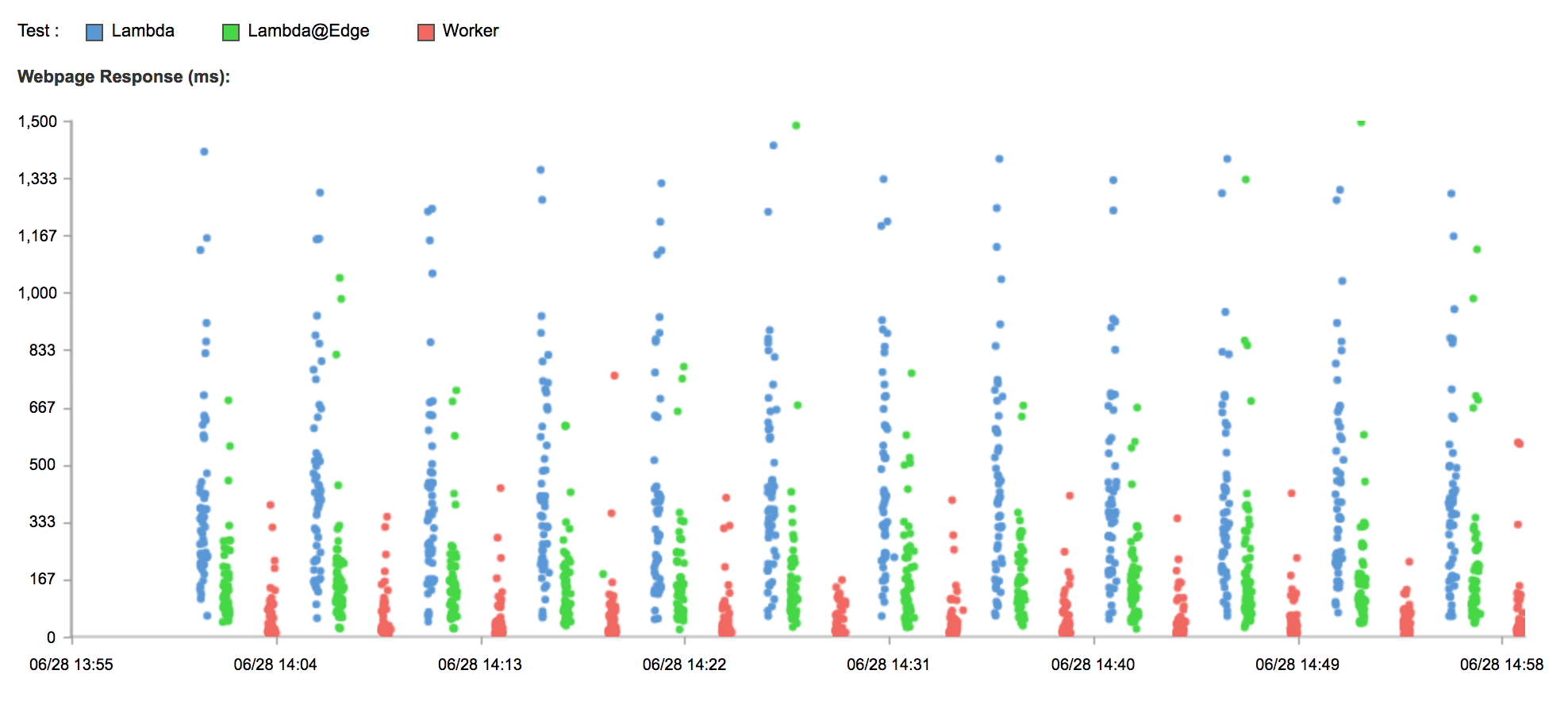
You can immediately see that Worker results are tightly clustered around the x-axis, Continue reading
Cryptocurrency API Gateway using Typescript+Workers
If you followed part one, I have an environment setup where I can write Typescript with tests and deploy to the Cloudflare Edge with npm run upload. For this post, I want to take one of the Worker Recipes further.
I'm going to build a mini HTTP request routing and handling framework, then use it to build a gateway to multiple cryptocurrency API providers. My point here is that in a single file, with no dependencies, you can quickly build pretty sophisticated logic and deploy fast and easily to the Edge. Furthermore, using modern Typescript with async/await and the rich type structure, you also write clean, async code.
OK, here we go...
My API will look like this:
| Verb | Path | Description |
|---|---|---|
| GET | /api/ping |
Check the Worker is up |
| GET | /api/all/spot/:symbol |
Aggregate the responses from all our configured gateways |
| GET | /api/race/spot/:symbol |
Return the response of the provider who responds fastest |
| GET | /api/direct/:exchange/spot/:symbol |
Pass through the request to the gateway. E.g. gdax or bitfinex |
The Framework
OK, this is Typescript, I get interfaces and I'm going to use them. Here's my ultra-mini-http-routing framework definition:
export interface IRouter {
route(req: RequestContextBase): IRouteHandler;
}
/**
* A route
*/
export interface IRoute Continue readingDelivering a Serverless API in 10 minutes using Workers
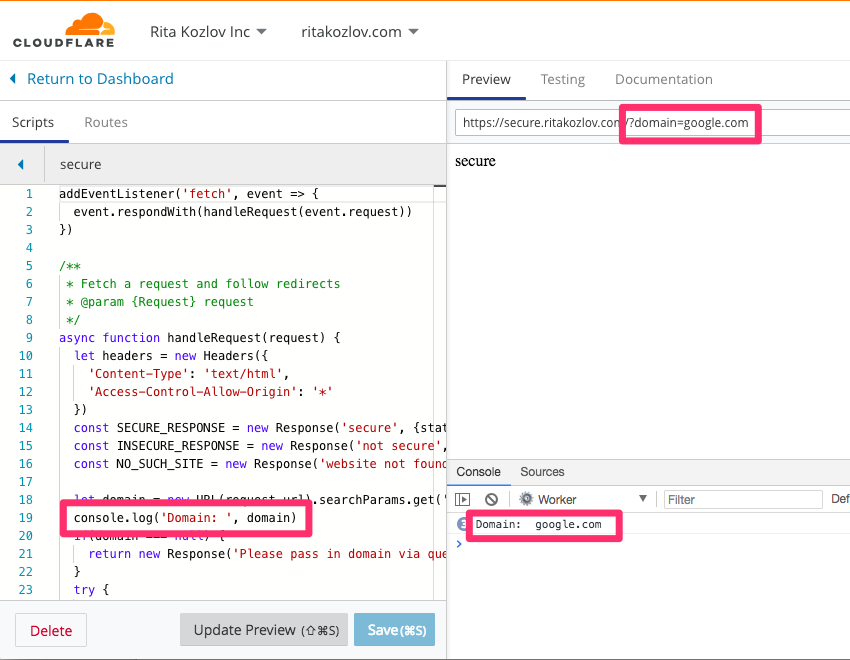
In preparation for Chrome’s Not Secure flag, which will update the indicator to show Not Secure when a site is not accessed over https, we wanted people to be able to test whether their site would pass. If you read our previous blog post about the existing misconceptions around using https, and preparing your site, you may have noticed a small fiddle, allowing you to test which sites will be deemed “Secure”. In preparation for the blog post itself, one of our PMs approached me asking for help making this fiddle come to life. It was a simple ask: we need an endpoint which runs logic to see if a given domain will automatically redirect to https.
The logic and requirements turned out to be very simple:
Make a serverless API endpoint
Input: domain (e.g. example.com)
Output: “secure” / “not secure”
Logic:
if http://example.com redirects to https://example.com
Return “secure”
Else
Return “not secure”
One additional requirement here was that we needed to follow redirects all the way; sites often redirect to http://www.example.com first, and only then redirect to https. That is an additional line of code I was prepared to handle.
I’ve done some Continue reading
T-25 days until Chrome starts flagging HTTP sites as “Not Secure”

Less than one month from today, on July 23, Google will start prominently labeling any site loaded in Chrome without HTTPS as "Not Secure".
When we wrote about Google’s plans back in February, the percent of sites loaded over HTTPS clocked in at 69.7%. Just one year prior to that only 52.5% of sites were loaded using SSL/TLS—the encryption protocol behind HTTPS—so tremendous progress has been made.
Unfortunately, quite a few Continue reading
Bootstrapping a Typescript Worker

Cloudflare Workers allows you to quickly deploy Javascript code to our 150+ data centers around the world and execute very close to your end-user. The edit/compile/debug story is already pretty amazing using the Workers IDE with integrated Chrome Dev Tools. However, for those hankering for some Typescript and an IDE with static analysis, autocomplete and that jazz, follow along to see one way to set up a Typescript project with Webstorm and npm run upload your code straight to the edge.
Pre Requisites
My environment looks like this:
- macOS High Sierra
- node v8.11.3
- npm v5.6.0
- Webstorm v2018.1.3
You'll also need a Cloudflare domain and to activate Workers on it.
I'll be using cryptoserviceworker.com
I'll also use Yeoman to build our initial scaffolding. Install it with npm install yo -g
Getting Started
Let's start with a minimal node app with a "hello world" class and a test.
mkdir cryptoserviceworker && cd cryptoserviceworker
npm install generator-node-typescript -g
yo node-typescript
That generator creates the following directory structure:
drwxr-xr-x 16 steve staff 512 Jun 18 20:40 .
drwxr-xr-x 10 steve staff 320 Jun 18 20:35 ..
-rw-r--r-- 1 steve staff 197 Jun 18 20:40 .editorconfig
-rw-r--r-- 1 steve staff Continue readingCopyright? Copywrong!

The drafting of the new EU Copyright Directive was never going to be an easy task. As has been seen over the years, policy discussions involving digital service providers and the intellectual property rights community are often polarizing, and middle ground can be difficult to find. However, the existing legal framework – which dates from 2001 - needed a refresh, in order to take account of the new online environment in which user-generated content is a key feature, while acknowledging the challenges that authors face and their need for fair remuneration.
Unfortunately, as is now so often the case in Brussels, the new law is being drafted with a small set of large Internet companies in mind. This blinkered approach to rule-making frequently results in unintended and negative consequences for other parts of the Internet ecosystem, and indeed for end users, many of whom are often unaware that such policies are being created.
Monitoring and Filtering User-Generated Content - A Flawed Approach
The draft copyright proposal has been undergoing EU Parliamentary and Council scrutiny since it was tabled by the European Commission in 2016, and it has been heavily criticised by civil society organisations, numerous industry associations, renowned academics and Continue reading
Using Webpack to bundle your Workers modules

A brief introduction to bundling your Service Worker scripts.
Photo by Joyce Romero / Unsplash
// The simplest Service Worker: A passthrough script
addEventListener('fetch', event => {
event.respondWith(fetch(event.request))
})
The code above is simple and sweet: when a request comes into one of Cloudflare’s data centers, passthrough to the origin server. There is absolutely no need for us to introduce any complex tooling or dependencies. Nevertheless, introduce we will! The problem is, once your script grows even just a little bit, you’ll be tempted to use JavaScript’s fancy new module system. However, in doing so, you’ll have a little bit of trouble uploading your script via our API (we only accept a single JS file).
Throughout this post, we’ll use contrived examples, shaky metaphors, and questionably accurate weather predictions to explain how to bundle your Service Worker with Webpack.
Webpack
Let’s just say Webpack is a module bundler. That is, if you have code in multiple files, and you tie them together like this:
app.js
// Import the CoolSocks class from dresser.js
import { CoolSocks } from './dresser'
import { FancyShoes } from './closet'
Then you can tell webpack to follow all of those Continue reading
Building a serverless Slack bot using Cloudflare Workers

Our Workers platform can be used for a ton of useful purposes: for A/B (multivariate) testing, storage bucket authentication, coalescing responses from multiple APIs, and more. But Workers can also be put to use beyond "HTTP middleware": a Worker can effectively be a web application in its own right. Given the rise of 'chatbots', we can also build a Slack app using Cloudflare Workers, with no servers required (well, at least not yours!).

What are we Building?
We're going to build a Slack bot (as an external webhook) for fetching the latest stock prices.
This Worker could also be adapted to fetch open issues from GitHub's API; to discover what movie to watch after work; anything with a REST API you can make query against.
Nevertheless, our "stock prices bot":
- Uses the Alpha Vantage API to fetch stock prices
- Caches a map of the top equities to their public identifiers, so you can request
/stocks MSFTas a shorthand. - Leverages Cloudflare's cache to minimize the need to hit the API on every invocation, whilst still serving recent price data.
Using the cache allows you to improve your bot's response times across all invocations of your Worker. It's also polite Continue reading

